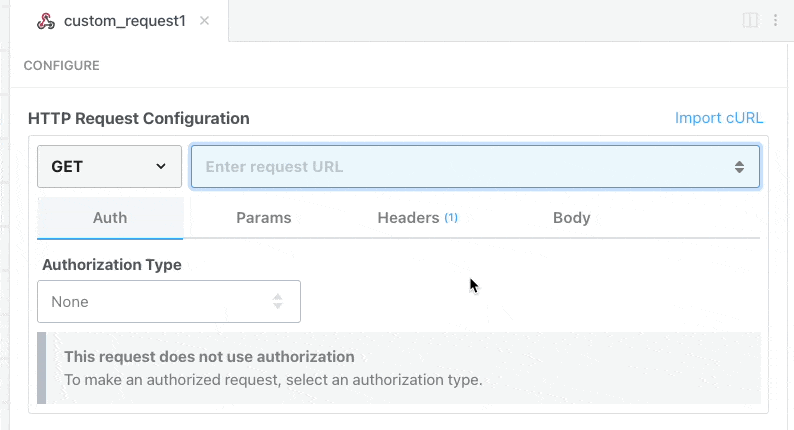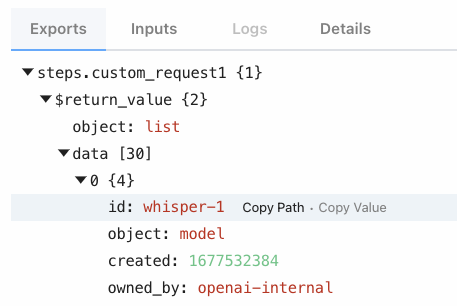import { ConfigurationError } from "@pipedream/platform";
import quickbooks from "../../quickbooks.app.mjs";
import { parseLineItems } from "../../common/utils.mjs";
export default {
key: "quickbooks-create-bill",
name: "Create Bill",
description: "Creates a bill. [See the documentation](https://developer.intuit.com/app/developer/qbo/docs/api/accounting/all-entities/bill#create-a-bill)",
version: "0.1.12",
annotations: {
destructiveHint: false,
openWorldHint: true,
readOnlyHint: false,
},
type: "action",
props: {
quickbooks,
vendorRefValue: {
propDefinition: [
quickbooks,
"vendorIds",
],
type: "string",
label: "Vendor ID",
description: "Reference to the vendor for this transaction",
optional: false,
},
currencyRefValue: {
propDefinition: [
quickbooks,
"currency",
],
},
lineItemsAsObjects: {
propDefinition: [
quickbooks,
"lineItemsAsObjects",
],
reloadProps: true,
},
},
async additionalProps() {
const props = {};
if (this.lineItemsAsObjects) {
props.lineItems = {
type: "string[]",
label: "Line Items",
description: "Line items of a bill. Set DetailType to `AccountBasedExpenseLineDetail`. Example: `{ \"DetailType\": \"AccountBasedExpenseLineDetail\", \"Amount\": 100.0, \"AccountBasedExpenseLineDetail\": { \"AccountRef\": { \"name\": \"Advertising\", \"value\": \"1\" } } }` [See the documentation](https://developer.intuit.com/app/developer/qbo/docs/api/accounting/all-entities/bill#create-a-bill) for more information.",
};
return props;
}
props.numLineItems = {
type: "integer",
label: "Number of Line Items",
description: "The number of line items to enter",
reloadProps: true,
};
if (!this.numLineItems) {
return props;
}
for (let i = 1; i <= this.numLineItems; i++) {
props[`account_${i}`] = {
type: "string",
label: `Line ${i} - Account ID`,
options: async ({ page }) => {
return this.quickbooks.getPropOptions({
page,
resource: "Account",
mapper: ({
Id: value, Name: label,
}) => ({
value,
label,
}),
});
},
};
props[`amount_${i}`] = {
type: "string",
label: `Line ${i} - Amount`,
};
}
return props;
},
methods: {
buildLineItems() {
const lineItems = [];
for (let i = 1; i <= this.numLineItems; i++) {
lineItems.push({
DetailType: "AccountBasedExpenseLineDetail",
Amount: this[`amount_${i}`],
AccountBasedExpenseLineDetail: {
AccountRef: {
value: this[`account_${i}`],
},
},
});
}
return lineItems;
},
},
async run({ $ }) {
if (!this.vendorRefValue || (!this.numLineItems && !this.lineItemsAsObjects)) {
throw new ConfigurationError("Must provide vendorRefValue, and lineItems parameters.");
}
const lines = this.lineItemsAsObjects
? parseLineItems(this.lineItems)
: this.buildLineItems();
lines.forEach((line) => {
if (line.DetailType !== "AccountBasedExpenseLineDetail") {
throw new ConfigurationError("Line Item DetailType must be `AccountBasedExpenseLineDetail`");
}
});
const response = await this.quickbooks.createBill({
$,
data: {
VendorRef: {
value: this.vendorRefValue,
},
Line: lines,
CurrencyRef: {
value: this.currencyRefValue,
},
},
});
if (response) {
$.export("summary", `Successfully created bill with ID ${response.Bill.Id}`);
}
return response;
},
};
 Chase Roberts@chsrbrts@benedictevans If you haven’t used @pipedream yet, then you haven’t lived.
Chase Roberts@chsrbrts@benedictevans If you haven’t used @pipedream yet, then you haven’t lived. ✨Ellie Day✨@heyelliedayEvaluation update: @pipedream has quite literally been a dream to work with! I’m excited to leverage this tool for all the various workflows I need to write. I’m currently at 11k invocations a day from the initial workflows I’ve written in the past couple weeks.
✨Ellie Day✨@heyelliedayEvaluation update: @pipedream has quite literally been a dream to work with! I’m excited to leverage this tool for all the various workflows I need to write. I’m currently at 11k invocations a day from the initial workflows I’ve written in the past couple weeks. Michael Braedley@MBraedleyUpdate: I got it working properly, and it's working so well that I'm dropping IFTTT. @pipedream can do everything that IFTTT basic can, and most (if not all things) IFTTT pro can for free or at a reasonable price if you need it. I am recommending it for basically any power user.
Michael Braedley@MBraedleyUpdate: I got it working properly, and it's working so well that I'm dropping IFTTT. @pipedream can do everything that IFTTT basic can, and most (if not all things) IFTTT pro can for free or at a reasonable price if you need it. I am recommending it for basically any power user. Thomas Cutting@mrthomascuttingWant quick+dirty integrations for a serverless workflow - @pipedream is my new go-to 😃
Thomas Cutting@mrthomascuttingWant quick+dirty integrations for a serverless workflow - @pipedream is my new go-to 😃 Matthew Roberts@mattdotrobertsday 013 - finally hit node js. This is the secret sauce of taking #nocode projects that one step further. Pumped about getting deeper into @pipedream now
Matthew Roberts@mattdotrobertsday 013 - finally hit node js. This is the secret sauce of taking #nocode projects that one step further. Pumped about getting deeper into @pipedream now Kenneth Auchenberg 💭@auchenbergYahoo Pipes is back! Kinda 😍 @pipedream
Kenneth Auchenberg 💭@auchenbergYahoo Pipes is back! Kinda 😍 @pipedream Raymond Camden 🥑@raymondcamdenAwesome video by the @pipedream folks showing real time twitter sentiment analysis integrated with Google Sheets. This is where Pipedream *really* shines, connecting systems together in easy workflows.
Raymond Camden 🥑@raymondcamdenAwesome video by the @pipedream folks showing real time twitter sentiment analysis integrated with Google Sheets. This is where Pipedream *really* shines, connecting systems together in easy workflows. Nacho Caballero@nachocaballeroI couldn't recommend @pipedream more. It's an amazing service to integrate different APIs. Much more powerful than Zapier and more user-friendly than AWS Lambda. I'm very proud to wear this t-shirt #NoCode
Nacho Caballero@nachocaballeroI couldn't recommend @pipedream more. It's an amazing service to integrate different APIs. Much more powerful than Zapier and more user-friendly than AWS Lambda. I'm very proud to wear this t-shirt #NoCode Jason Snow@jyksnwDeveloped a working prototype environmental sensor IoT solution with @particle Photon, @pipedream, and @MongoDB with full graphing and alerting in less than a day! All amazing technology, will def. be exploring these more.
Jason Snow@jyksnwDeveloped a working prototype environmental sensor IoT solution with @particle Photon, @pipedream, and @MongoDB with full graphing and alerting in less than a day! All amazing technology, will def. be exploring these more. Steven Terrana@steven_terrana@burgwyn you've inspired me to finally set up my own blog. I'll make sure my first blog post explains the tech behind the setup. think @obsdmd + @GatsbyJS + @pipedream.
Steven Terrana@steven_terrana@burgwyn you've inspired me to finally set up my own blog. I'll make sure my first blog post explains the tech behind the setup. think @obsdmd + @GatsbyJS + @pipedream. 🚄 James Augeri, PhD@DotDotJamesWant to low-code your back end, need more horsepower than @Bubble / @KnackHQ, or just miss Yahoo! Pipes? Check out @PipeDream
🚄 James Augeri, PhD@DotDotJamesWant to low-code your back end, need more horsepower than @Bubble / @KnackHQ, or just miss Yahoo! Pipes? Check out @PipeDream Sébastien Chopin@AtinuxGitHub issues should be like @linear_app for maintainers. Looking forward more integrations with GH actions or tools like @pipedream 👀
Sébastien Chopin@AtinuxGitHub issues should be like @linear_app for maintainers. Looking forward more integrations with GH actions or tools like @pipedream 👀 Raul@raul_predescuIf you're a dev and not using @pipedream, you're missing out. Been using it for months, daily. FREE for devs. Plenty of integrations and good limits. Absolutely love it.
Raul@raul_predescuIf you're a dev and not using @pipedream, you're missing out. Been using it for months, daily. FREE for devs. Plenty of integrations and good limits. Absolutely love it. Bruno Skvorc@bitfallsSo @pipedream is pretty amazing. In 3 minutes I just made a flow which adds @rickastley's Never Gonna Give You Up to my @spotify playlist whenever a new pull request arrives in an old repo of mine.
Bruno Skvorc@bitfallsSo @pipedream is pretty amazing. In 3 minutes I just made a flow which adds @rickastley's Never Gonna Give You Up to my @spotify playlist whenever a new pull request arrives in an old repo of mine. Zach Lanich@ZachLanichUm, wow 🤯 @pipedream
Zach Lanich@ZachLanichUm, wow 🤯 @pipedream Steven Bell@bellontechI just used @pipedream to build a Shopify App. Wow, they make small backed tasks easy.
Steven Bell@bellontechI just used @pipedream to build a Shopify App. Wow, they make small backed tasks easy. Jay Hack 🎩🇺🇸@_jayhack_Very impressed with this bad boi - it reminds me of a @PalantirTech internal tool, but geared towards integrations instead of data analysis and far more customizable. Great expectations here 🚀🤩
Jay Hack 🎩🇺🇸@_jayhack_Very impressed with this bad boi - it reminds me of a @PalantirTech internal tool, but geared towards integrations instead of data analysis and far more customizable. Great expectations here 🚀🤩 Tree Sturgeon 🔥🚴♂️🌳@philsturgeonFor context this is day 2 of a really challenging and stupid migration from Notion to @airtable with disparate/missing data. It's going better than expected and thanks to @pipedream I don't have to bother the iOS dev to add W3W.
Tree Sturgeon 🔥🚴♂️🌳@philsturgeonFor context this is day 2 of a really challenging and stupid migration from Notion to @airtable with disparate/missing data. It's going better than expected and thanks to @pipedream I don't have to bother the iOS dev to add W3W.




